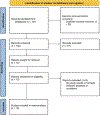Meta-Analysis of the Performance of AI-Driven ECG Interpretation in the Diagnosis of Valvular Heart Diseases
- PMID: 38103769
- PMCID: PMC10842912
- DOI: 10.1016/j.amjcard.2023.12.015
Meta-Analysis of the Performance of AI-Driven ECG Interpretation in the Diagnosis of Valvular Heart Diseases
Abstract
Valvular heart diseases (VHDs) significantly impact morbidity and mortality rates worldwide. Early diagnosis improves patient outcomes. Artificial intelligence (AI) applied to electrocardiogram (ECG) interpretation presents a promising approach for early VHD detection. We conducted a meta-analysis on the efficacy of AI models in this context. We reviewed databases including PubMed, MEDLINE, Embase, Scopus, and Cochrane until August 20, 2023, focusing on AI for ECG-based VHD detection. The outcomes included pooled accuracy, sensitivity, specificity, positive predictive value (PPV), and negative predictive value. The pooled proportions were derived using a random-effects model with 95% confidence intervals (CIs). Study heterogeneity was evaluated with the I-squared statistic. Our analysis included 10 studies, involving ECG data from 713,537 patients. The AI algorithms mainly screened for aortic stenosis (n = 6), mitral regurgitation (n = 4), aortic regurgitation (n = 3), mitral stenosis (n = 1), mitral valve prolapse (n = 2), and tricuspid regurgitation (n = 1). A total of 9 studies used convolution neural network models, whereas 1 study combined the strengths of support vector machine logistic regression and multilayer perceptron for ECG interpretation. The collective AI models demonstrated a pooled accuracy of 81% (95% CI 73 to 89, I² = 92%), sensitivity was 83% (95% CI 77 to 88, I² = 86%), specificity was 72% (95% CI 68 to 75, I² = 52%), PPV was 13% (95% CI 7 to 19, I² = 90%), and negative predictive value was 99% (95% CI 97 to 99, I² = 50%). The subgroup analyses for aortic stenosis and mitral regurgitation detection yielded analogous outcomes. In conclusion, AI-driven ECG offers high accuracy in VHD screening. However, its low PPV indicates the need for a combined approach with clinical judgment, especially in primary care settings.
Keywords: aortic stenosis; artificial intelligence; electrocardiograms; mitral regurgitation; valvular heart disease.
Copyright © 2023 Elsevier Inc. All rights reserved.
Conflict of interest statement
Declaration of competing interest The authors have no competing interest to declare.
Figures
References
-
- Vaid A, Argulian E, Lerakis S, Beaulieu-Jones BK, Krittanawong C, Klang E, Lampert J, Reddy VY, Narula J, Nadkarni GN, Glicksberg BS. Multi-center retrospective cohort study applying deep learning to electrocardiograms to identify left heart valvular dysfunction. Commun Med (Lond) 2023;3:24. - PMC - PubMed
-
- Writing Committee M, Otto CM, Nishimura RA, Bonow RO, Carabello BA, Erwin JP 3rd, Gentile F, Jneid H, Krieger EV, Mack M, McLeod C, O’Gara PT, Rigolin VH, Sundt TM 3rd, Thompson A, Toly C. 2020 ACC/AHA guideline for the management of patients with valvular heart disease: executive summary: a report of the American College of Cardiology/American Heart Association Joint Committee on Clinical Practice Guidelines. J Am Coll Cardiol 2021;77:450–500. - PubMed
-
- Sawano S, Kodera S, Katsushika S, Nakamoto M, Ninomiya K, Shinohara H, Higashikuni Y, Nakanishi K, Nakao T, Seki T, Takeda N, Fujiu K, Daimon M, Akazawa H, Morita H, Komuro I. Deep learning model to detect significant aortic regurgitation using electrocardiography. J Cardiol 2022;79:334–341. - PubMed
-
- Lin GM, Zeng HC. Electrocardiographic machine learning to predict mitral valve prolapse in young adults. IEEE Access 2021;9:103132–103140.
-
- Ulloa-Cerna AE, Jing L, Pfeifer JM, Raghunath S, Ruhl JA, Rocha DB, Leader JB, Zimmerman N, Lee G, Steinhubl SR, Good CW, Haggerty CM, Fornwalt BK, Chen R. rECHOmmend: an ECG-based machine learning approach for identifying patients at increased risk of undiagnosed structural heart disease detectable by echocardiography. Circulation 2022;146:36–47. - PMC - PubMed
Publication types
MeSH terms
Grants and funding
LinkOut - more resources
Full Text Sources
Medical



